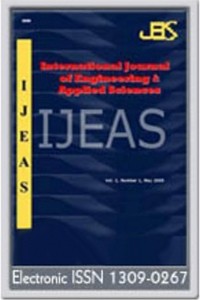Pareto-Optimality and V.E.G.A. to Multi- Input Multi-Output (M.I.M.O.) System Reduction
A VEGA (Vector Evaluated Genetic Algorithm) based computer-aided method to derive a reduced order (rth-order) approximant for given (stable) multi-input multi-output (MIMO) linear continuous-time system is presented. In this method, stability and the first r time moments/Markov parameters are preserved as well as the errors between a set of subsequent time moments/Markov parameters of the system and those of the model are minimized. The method is useful as it guarantees improvement as well as alleviates the problems of deciding the values of number of error functions to be minimized and values of weights on the errors which were left unresolved in previous methods. The search area for GA is very wide and it usually converges to a point near global optima
Keywords:
Model reduction Padé approximants, Routh criteria, G.A,
___
- Appiah, R.K, Pade methods of Hurwitz polynomial approximation with application to linear system reduction, Int. J.Control. 29: 39-48, 1979.
- Ashoor, N. and Singh, V., A note on low order modeling, IEEE Trans. Automat. Contr., 27, 1124-1126, 1982.
- Ashoor, N. and Singh, V., Remarks on system simplification under consideration of time response, Electron. Lett., 18, 496-497, 1982.
- Choo, Y. Improvement to modified Routh approximation method., Electron. Lett. , 35, 606-607. 1999.
- Choo, Y., Improvement to modified Routh approximation method (correction), Electron. Lett., 1119, 1999.
- Choo, Y., Direct method for obtaining modified Routh approximants., Electron. Lett., 35, 627–1628 1999.
- Choo, Y., Improved bilinear Routh approximation method for discrete time systems, Trans. ASME J. Dyn. Syst. Meas. Control., 123, 125–127, 2001.
- Choo, Y., Equivalence of bilinear Routh and Schwarz approximation methods for discrete time systems, Electron. Lett., 38, 761–762, 2002.
- Choo, Y. and Dongmin, K., SISO Continuous System Reduction via impulse response Gramian by iterative formulae, Trans. ASME J. Dyn. Syst. Meas. Contr., 128: 391-393, 2006.
- 0]Dolgin, Y. and Zeheb, E., On Routh-Pade model reduction of interval systems, IEEE Trans. Autom. Control, 48, 1610–1612,2003.
- 1] Deb., K., Multi-objective Optimization using Evolutionary Algorithm., New York, John Wiley and Sons Ltd., 2002.
- 2] Hsieh, C.S and Hwang, C., Model reduction of continuous-time system using a modified Routh-approximation method, IEE Proc. D. Control Theory Appl., 136, 151–156 1989.
- 3] Householder, A.S., The numerical treatment of single non-linear equation, McGraw-Hill Book Co., New -Newyork 1970.
- 4]Hwang, C. and Hwang, J.H. and Guo, T.Y., Multifrequency Routh Approximants for linear systems, IEE Proc. Control Theory Applicat. , 142, 351-358, 1975.
- 5] Hwang, C.Y. and Lee, Y.C., A new family of Routh approximants. Circuits Syst. Signal Process. , 16, 1-25, 1997.
- 6] Hwang, C. and Yang, S.F., Comments on the computation of interval Routh approximants., IEEE Trans. Autom. Control., 44, 1782–1787, 1999.
- 7] Kelley, K.J., Aircraft manoeuvre optimization by reduced order approximation control and dynamic system (Ed:C.T. Leondes), Academic Press London, 132-174, 1973.
- 8] Krishnamurthy V. and V. Sheshadri , A simple and direct method of reduction order of linear systems using routh approximation in frequency domain IEEE Trans. Autom. Control. 21, 797-799, 1976.
- 9] Luss, R.and Jaakola, T., Direct search and systematic reduction of size of search region. AICHE J., 19, 760-766, 1973.
- 0]Lucas, T.N., The bilinear method: a new stability-preserving order reduction approach. Proc. Inst. Mech. Engg. I. J. Syst. Contr. Engg., 216, 429-436, 2002.
- 1]Lucas, T.N., Constrained optimal Pade model reduction., ASME J .Dyna. Syst. Meas. Control, 119, 685-690, 1997.
- 2]Lee, Y.C. and Hwang, C.and Hwang J.H., Model-reduction of SISO systems by Routh expansion and balancing method., J. Franklin Inst., 331B, 367–380, 1994.
- 3]Lucas, T.N., 1988. Scaled impulse energy approximation for model reduction, IEEE Trans.Automat. Contr., 133, 791-793, 1998.
- 4] Manigandan T., Devarajan N. and Svanandam S.N. Design of PID controller using reduced order model, Academic Open Internet Journal, 15, 1-15, 2005.
- 5] Pal, J., State reduced-order Padé approximants using Routh-Hurwitz array, Electron. Lett. , 15, 25-26, 1979.
- 6]Parks, P.C, A new proof of the Routh-Hurwitz criterion using the second method of Lyapunov, Proc. Camb. Philos. Soc., 694-702, 1962.
- 7] Pal, J., Improved Pade approximants using stability equation method, Electron. Lett., 19, 426-427, 1983.
- 8] Puri, V. and Lim, D.P. , Stable model reduction by impulse response error minimization using Michailov criterion and Pade´ approximation, Trans. ASME J. Dyn. Syst. Meas.Control, 110, 389–394, 1988.
- 9] Singh, V., Obtaining Routh-Pade approximants using Luss-Jaakola algorithm, IEE Proc. Part I, 152.. 129-132, 2005.
- 0]Singh, V. and Dinesh Chandra, and Kar, H., Improved Routh-Pade approximants: A computer –aided approach., IEEE Trans. Automat. Contr., 49, 292-295, 2004 .
- 1]Singh V. Stable approximants for stable systems: A new approach, Proc. IEEE., 69, 1155-1156, 1981.
- 2]Singh, V., Nonuniqueness of model reduction using the Routh approach, IEEE Trans. Autom. Control, 24, 650-651, 1979.
- 3]Shamash, Y., Truncation method of reduction: a viable alternative, Electron. Lett. , 17, 97-98, 1981.
- 4] Shamash, Y., Model reduction usng the Routh stability criterion and the Pade approximation technique, Int. J. Control, 21, 475-484, 1975.
- 5] Shamash, Y., Stable biased reduced-order models using the Routh method of Reduction, Int. J. Syst. Sci.., 11, 641-654, 1980.
- 6] Tian, Z, Hoo, K., Stable Shared model for MIMO systems, Journal of Control Theory and applications, 4, 348-356, 2005.
- 7] Shamash, Y., The viability of analytical methods for the reduction of multivariable systems, Proc. of IEEE, 69, 1163-1164, 1981.
- Başlangıç: 2009
- Yayıncı: Akdeniz Üniversitesi
Sayıdaki Diğer Makaleler
O. Hasançebi, F. Erdal, M. P. Saka
A. Şencan, B. Kılıç, R. Selbaş
M. Sedighizadeh, A. Rezazadeh, M. Parayandeh
K. Venkateswarlu, B.S.R Murthy
